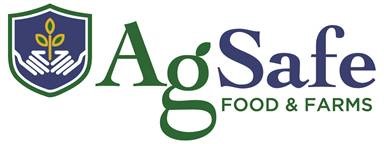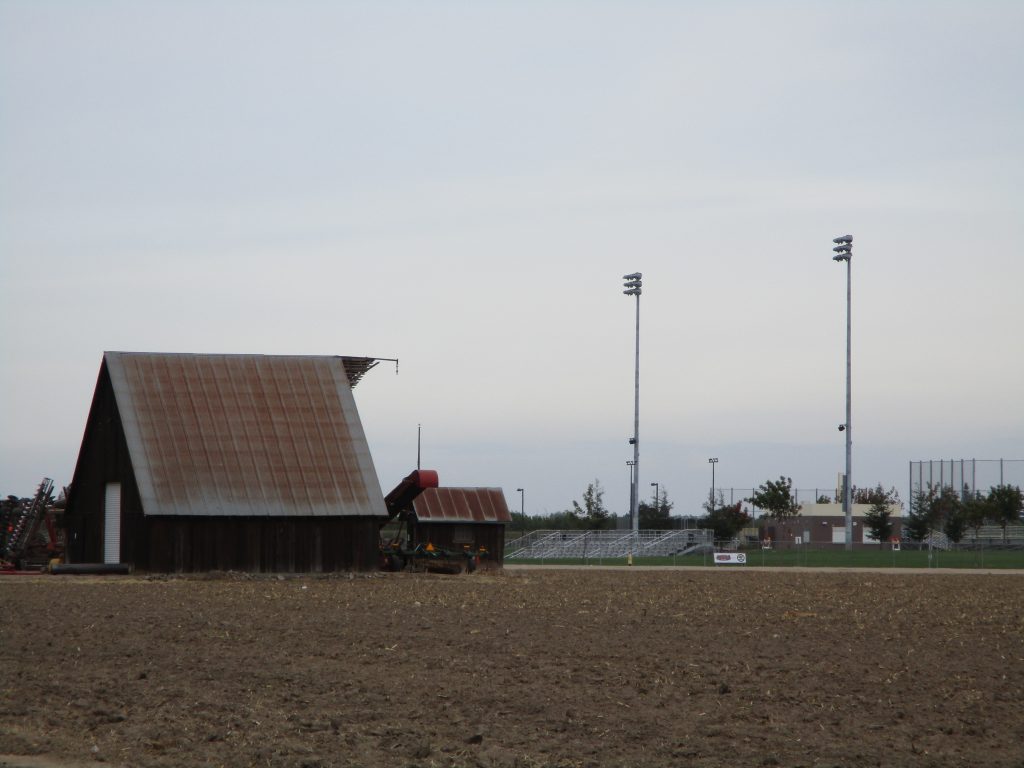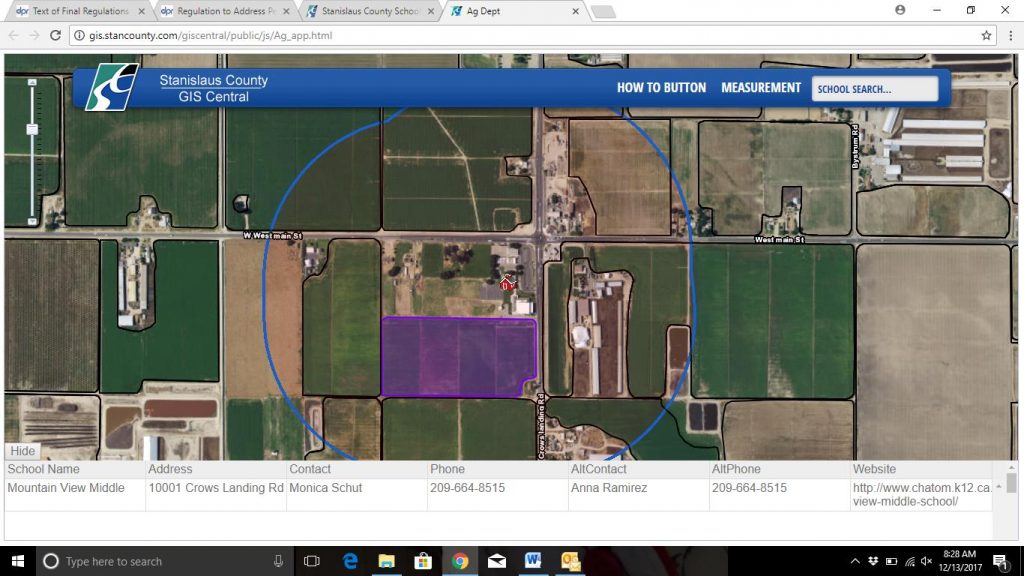
Via Agsafe
Anna Genasci, QAL
Assistant Director of Education, AgSafe
anna@agsafe.org
209-526-4400
The California Department of Pesticide Regulation (DPR) recently adopted a new regulation that restricts pesticide use around public schools and daycares. The rules, which took effect on January 1, 2018, also require annual notification to the schools, daycares and county agricultural commissioner’s office. In the past, individual counties had permit conditions that set rules concerning pesticide use around schools and daycares, but with the adoption of this new regulation, the rules will be consistent throughout the state.
Definition of School and Daycare:
- “School site” means any property used as a child day care facility, as defined in Health and Safety Code section 1596.750, or for a kindergarten, elementary, or secondary school. This includes all areas of the property used on weekdays by children who attend such facilities or schools, or other property identified by the commissioner as a park adjacent to a school that is used by the school for recess, sports, or other school activities.
- “School site” does not include: family day care homes as defined in Health and Safety Code section 1596.78; any postsecondary educational facility attended by secondary pupils; private kindergarten, elementary, or secondary school facilities; or vehicles or bus stops not on school site property.
Application Restrictions:
Pesticide application restrictions will apply Monday through Friday, during the hours of 6:00 a.m. to 6:00 p.m., depending on the distance from the treated area to a school site, the application equipment used, and the type of pesticide applied. The type of pesticide is not the product formulation but rather the final form applied, for example if a powder is mixed with water and then applied, this is considered a liquid application. During these time periods, the owner of the property and the applicator shall assure that an application is not made within the distance of the school site as described below.
- There must be a minimum ¼ mile distance restriction for applications using a:
- Aircraft
- Airblast sprayer or other ground application equipment with a pump that delivers spray into an air stream created by a fan
- Sprinkler chemigation equipment
- Dust or powder
- Fumigant
- There must be a minimum of a 25-foot distance restriction when using a:
- Ground-rig sprayer. However, if this type of equipment is used to apply a dust, powder, or fumigant, the ¼ mile distance restriction applies.
- Field soil injection equipment. However, if this type of equipment is used to apply a fumigant, the ¼ mile distance restriction applies; or if used to apply a dust or powder, there is no minimum distance restriction.
- Other application equipment not identified in this section, such as drip or flood chemigation equipment. However, if this type of equipment is used to apply dust, powder, or fumigant, the ¼ mile distance restriction applies.
- There is no distance restriction when:
- The application is made within an enclosed space, such as a greenhouse. However, when applying a fumigant, the ¼ mile distance restriction applies.
- The application is made using bait stations.
- A pesticide is applied as a dust or powder using field soil injection equipment.
- A pesticide is applied as a granule, flake, or pellet. However, when the pesticide product formulation is applied as a fumigant, or applied by aircraft, the ¼ mile distance restriction applies.
- An application is made using a backpack sprayer. However, when this type of equipment incorporates an airblast sprayer or is used to apply a dust or powder, the ¼ mile distance restriction applies.
- An application is made using a hand pump sprayer. However, when this type of equipment is used to apply a dust, powder, or fumigant, the ¼ mile distance restriction applies.
- Additionally, there is no distance restriction when:
- School classes are not scheduled for the day of application.
- The child day care facility is closed during the entire day of the application.
- In addition to the time period and distance restriction specified above, fumigants cannot be applied when school classes are scheduled or child day care facilities are open within 36 hours following fumigation.
- The application restrictions do not apply when there is a written agreement between the owner of the property, the principal or child day care facility administrator, and the commissioner that specifies alternative application restrictions that the parties agree provide the same or a greater level of protection. Any party may rescind the agreement at any time by notifying the other parties in writing. The commissioner shall enforce a written agreement for restrictions as if they were requirements in regulation.
“Pesticide application restrictions will apply Monday through Friday, during the hours of 6:00 a.m. to 6:00 p.m., depending on the distance from the treated area to a school site, the application equipment used, and the type of pesticide applied.”
Notification Requirements:
- For all applications of pesticides expected to be made for the production of an agricultural commodity within ¼ mile of a school site, the owner of the property to be treated shall provide annual notification;
- No later than April 30 of pesticide(s) expected to be used from July 1 of the current year through June 30 of the next year.
- Effective April 1, 2018, if the owner of the property to be treated changes, the new property owner shall provide the notification within 30 days of assuming control of that property for expected pesticide(s) to be used from the time the notification is provided through June 30 of the following year.
- The annual notification must be provided to: The principal of the public K-12 school; the administrator of the child day care facility; and the county agricultural commissioner.
- The annual notification must be in writing and include the following information:
- A summary of the owner of the property’s requirements to provide annual notification to a school site
- A summary of the applicable pesticide application restrictions
- Owner of the property’s name and contact information
- Map showing location of the field(s) involved and the school or child day care facilities
- County agricultural commissioner’s contact information
- National Pesticide Information Center Web site address
- Information on the pesticide(s) expected to be used including: name of each active ingredient, or principal functioning agent for a spray adjuvant; example pesticide product name(s); and the U.S. Environmental Protection Agency or California registration number.
- The following statements: “This notification is informational only, and includes a list of pesticides expected to be used. Beginning July 1, 2018, school sites will be informed of pesticides not on the list at least 48 hours prior to their use. The county agricultural commissioner may be contacted for questions or additional information; if violations of these requirements are suspected; or other non-emergency situations.
- A description of the option to negotiate an alternate to the required application restrictions
- The property owner shall retain a copy of each annual notification for two years and make them available to the Director or commissioner upon request. The commissioner shall retain a copy of each annual notification for one year.
- No later than April 30 of pesticide(s) expected to be used from July 1 of the current year through June 30 of the next year.
To read through the complete regulation, visit; http://www.cdpr.ca.gov/docs/legbills/rulepkgs/16-004/16-004_final_text.pdf.
“For all applications of pesticides expected to be made for the production of an agricultural commodity within ¼ mile of a school site, the owner of the property to be treated, shall provide annual notification.”
Notification Compliance:
With the implementation of this new rule, the County Agricultural Commissioner’s Offices (CACs) are working with DPR to develop an electronic notification system that is accessed through CalAgPermits (CAPS). CAPS is the pesticide permitting system used by counties throughout California.
Information, such as pesticide used at each site will automatically populate the grower’s notification e-form. All the locations of public schools and licensed daycares have been digitized statewide and will be visible in CAPS. The system will determine which ag production sites are within 1/4 mile of a public school/licensed daycare and send them the e-notification once the grower completes and approves the notice.
All affected growers will receive a packet of information explaining the new notification regulation and how to use the electronic notification module in CAPS. When the notification module is released (added to CAPS) growers can request help during permits renewals. CAC have conducted a number of CEs that covered the new notification regulation and we will offer additional CEs after January 1st targeting affected growers and PCAs.
According to DPR, “The regulation is expected to affect about 4,100 public K-12 schools and licensed child day-care facilities and approximately 2,500 growers in California.”
For more information about pesticide use around schools and daycares, or any worker safety, health, human resources, labor relations, or food safety issues, please visit www.agsafe.org, call us at (209) 526-4400 or via email at safeinfo@agsafe.org.
AgSafe is a 501c3 nonprofit providing training, education, outreach and tools in the areas of safety, labor relations, food safety and human resources for the food and farming industries. Since 1991, AgSafe has educated nearly 75,000 employers, supervisors, and workers about these critical issues.


